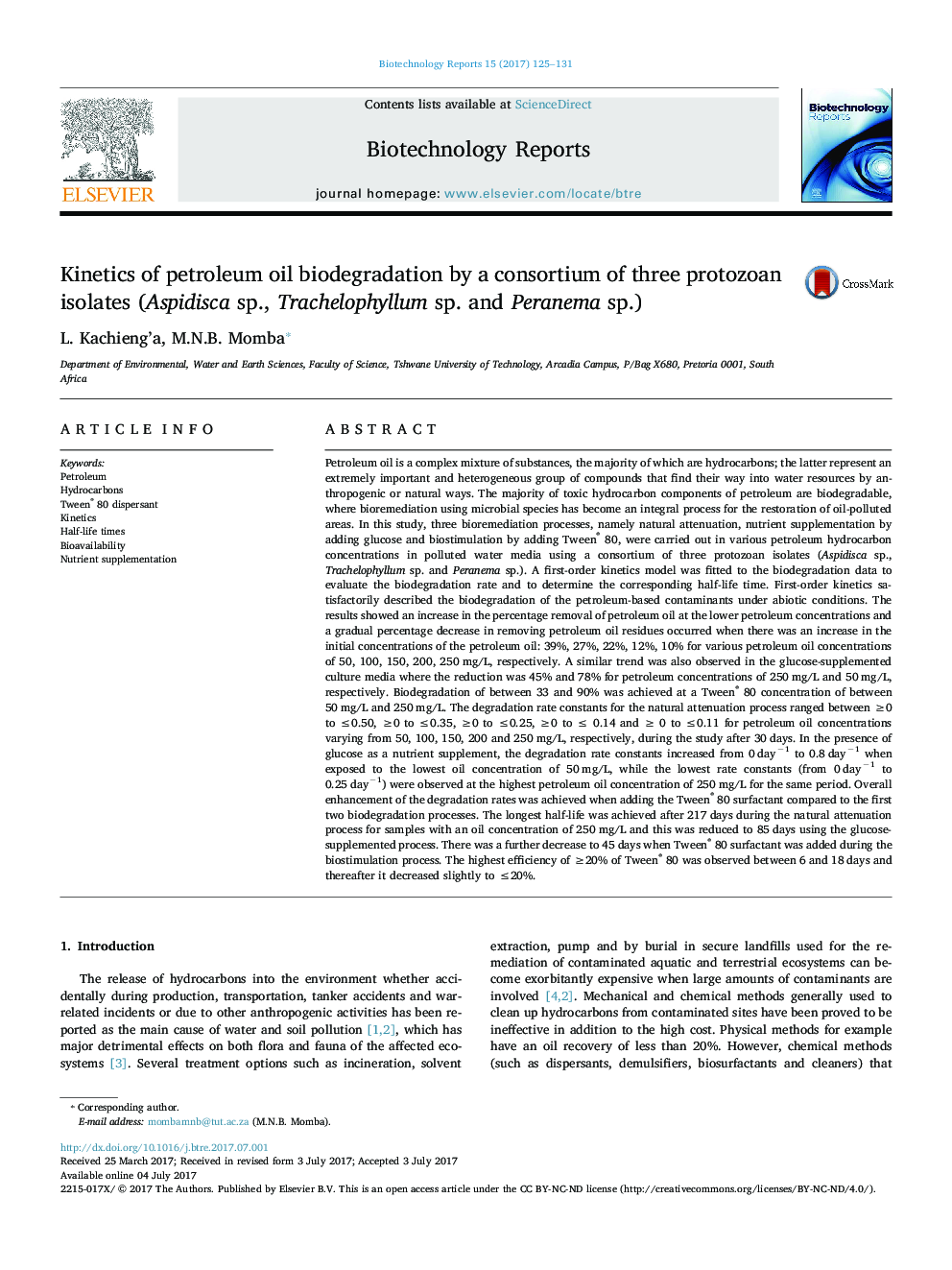| کد مقاله | کد نشریه | سال انتشار | مقاله انگلیسی | نسخه تمام متن |
|---|---|---|---|---|
| 5031775 | 1471016 | 2017 | 7 صفحه PDF | دانلود رایگان |

- There was an increase in the percentage removal of petroleum oil in low concentrations.
- There was a reduction of 45% and 78% for petroleum concentrations of 250Â mg/L and 50Â mg/L, respectively in glucose-supplemented culture media.
- Biodegradation of between 33 and 90% was achieved at a Tween® 80 concentration.
- The highest efficiency of â¥20% of Tween® 80 was observed between 6 and 18 days.
Petroleum oil is a complex mixture of substances, the majority of which are hydrocarbons; the latter represent an extremely important and heterogeneous group of compounds that find their way into water resources by anthropogenic or natural ways. The majority of toxic hydrocarbon components of petroleum are biodegradable, where bioremediation using microbial species has become an integral process for the restoration of oil-polluted areas. In this study, three bioremediation processes, namely natural attenuation, nutrient supplementation by adding glucose and biostimulation by adding Tween® 80, were carried out in various petroleum hydrocarbon concentrations in polluted water media using a consortium of three protozoan isolates (Aspidisca sp., Trachelophyllum sp. and Peranema sp.). A first-order kinetics model was fitted to the biodegradation data to evaluate the biodegradation rate and to determine the corresponding half-life time. First-order kinetics satisfactorily described the biodegradation of the petroleum-based contaminants under abiotic conditions. The results showed an increase in the percentage removal of petroleum oil at the lower petroleum concentrations and a gradual percentage decrease in removing petroleum oil residues occurred when there was an increase in the initial concentrations of the petroleum oil: 39%, 27%, 22%, 12%, 10% for various petroleum oil concentrations of 50, 100, 150, 200, 250 mg/L, respectively. A similar trend was also observed in the glucose-supplemented culture media where the reduction was 45% and 78% for petroleum concentrations of 250 mg/L and 50 mg/L, respectively. Biodegradation of between 33 and 90% was achieved at a Tween® 80 concentration of between 50 mg/L and 250 mg/L. The degradation rate constants for the natural attenuation process ranged between â¥0 to â¤0.50, â¥0 to â¤0.35, â¥0 to â¤0.25, â¥0 to ⤠0.14 and ⥠0 to â¤0.11 for petroleum oil concentrations varying from 50, 100, 150, 200 and 250 mg/L, respectively, during the study after 30 days. In the presence of glucose as a nutrient supplement, the degradation rate constants increased from 0 dayâ1 to 0.8 dayâ1 when exposed to the lowest oil concentration of 50 mg/L, while the lowest rate constants (from 0 dayâ1 to 0.25 dayâ1) were observed at the highest petroleum oil concentration of 250 mg/L for the same period. Overall enhancement of the degradation rates was achieved when adding the Tween® 80 surfactant compared to the first two biodegradation processes. The longest half-life was achieved after 217 days during the natural attenuation process for samples with an oil concentration of 250 mg/L and this was reduced to 85 days using the glucose-supplemented process. There was a further decrease to 45 days when Tween® 80 surfactant was added during the biostimulation process. The highest efficiency of â¥20% of Tween® 80 was observed between 6 and 18 days and thereafter it decreased slightly to â¤20%.
Journal: Biotechnology Reports - Volume 15, September 2017, Pages 125-131